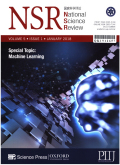- 钛学术文献服务平台 \
- 学术期刊 \
- 科教文艺期刊 \
- 科研管理期刊 \
- 国家科学评论(英文版)期刊 \
Majorana gets an iron twist
Majorana gets an iron twist
基本信息来源于合作网站,原文需代理用户跳转至来源网站获取
摘要:
A magical coincidence of condensedmatter physics occurred in 2008.In February of that year, a new kind of high-Tc (26 K) superconductivity was reported in the fluorine-doped iron-based superconductor (FeSC)La[O1-xFx]FeAs [1], starting the'Iron Age'of superconductivity.In the following April, a 3D topological insulator (TI) was verified in Bi-Sb alloy [2], triggering a worldwide wave of searching for more 3D TI materials.A little earlier, in that March, a new hope was also raised in the Majorana community.An ingenious idea was proposed by Fu and Kane [3]for creating self-conjugate Majorana bound states (MBSs), a condensed matter version of the famous Majorana fermion, in a TI/s-wave superconductor heterostructure, which is much easier to realize in experiments than the previously proposed p-wave superconductor platform.These topics soon became three major rivers in condensed-matter physics, and they come together with the recent discovery of topological band structure and Majorana bound states in a simple FeSC.

推荐文章
The occurrences and geochemical characteristics of thorium in iron ore in the Bayan Obo deposit, Nor
Thorium
Occurrence state
Distribution law
Geochemical characteristics
Iron ore
Bayan Obo deposit
A preliminary study on ore-forming environments of Xianglushan-type iron deposit and the weathering
Emeishan basalt paleo-weathering crust
Xianglushan-type iron deposit
Ore-forming environment
Weathering mineralization
Western Guizhou Province
Microaerobic iron oxidation and carbon assimilation and associated microbial community in paddy soil
Paddy soil
Microaerobic Fe(Ⅱ)-oxidation
CO2 assimilation
SIP
沉默Twist基因对食管癌细胞生长迁徙和侵袭的影响
Twist沉默
食管癌
凋亡
内容分析
关键词云
关键词热度
相关文献总数
(/次)
(/年)
文献信息
| 篇名 | Majorana gets an iron twist | ||
| 来源期刊 | 国家科学评论(英文版) | 学科 | |
| 关键词 | |||
| 年,卷(期) | 2019,(2) | 所属期刊栏目 | |
| 研究方向 | 页码范围 | 195-197 | |
| 页数 | 3页 | 分类号 | |
| 字数 | 语种 | 英文 | |
| DOI | 10.1093/nsr/nwy143 | ||
五维指标
引文网络
引文网络
二级参考文献 (0)
共引文献 (0)
参考文献 (1)
节点文献
引证文献 (0)
同被引文献 (0)
二级引证文献 (0)
2008(1)
- 参考文献(1)
- 二级参考文献(0)
2019(0)
- 参考文献(0)
- 二级参考文献(0)
- 引证文献(0)
- 二级引证文献(0)
引文网络交叉学科
相关学者/机构
期刊影响力
国家科学评论(英文版)
主办单位:
中国科技出版传媒股份有限公司
出版周期:
月刊
ISSN:
2095-5138
CN:
10-1088/N
开本:
大16开
出版地:
北京市
邮发代号:
80-671
创刊时间:
2014
语种:
eng
出版文献量(篇)
773
总下载数(次)
0
总被引数(次)
431
期刊文献
相关文献
推荐文献

 免费查重
免费查重










